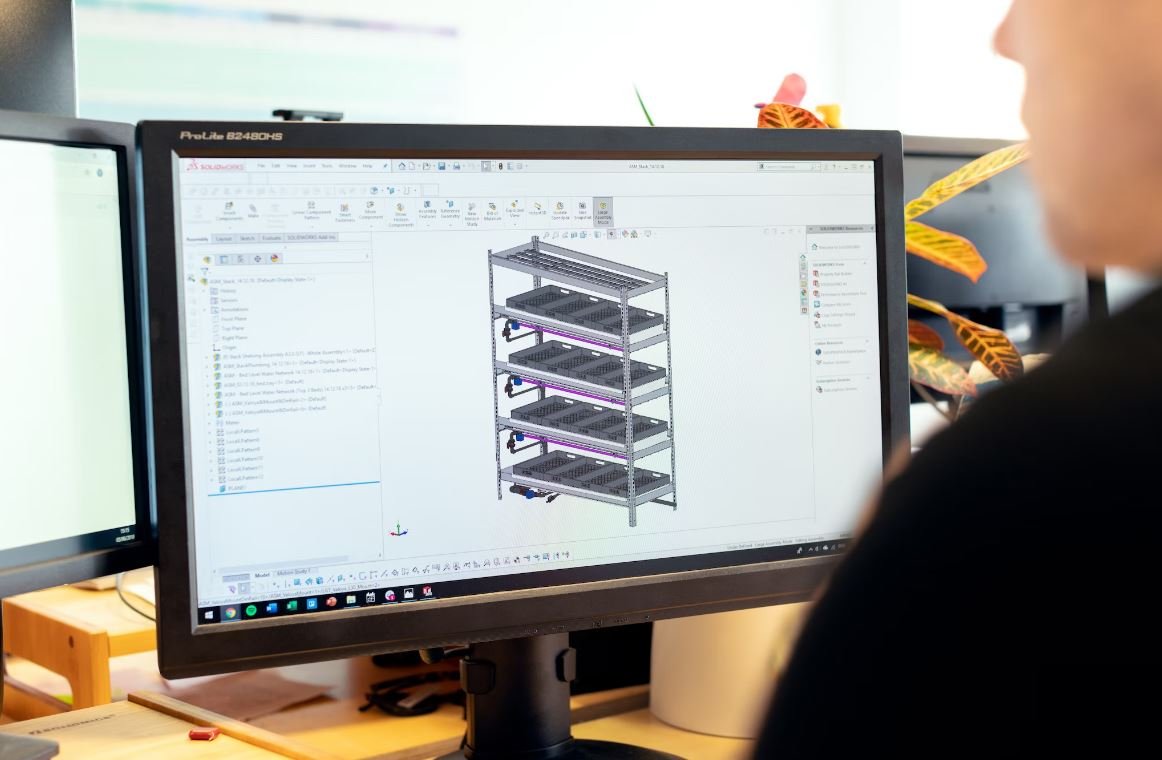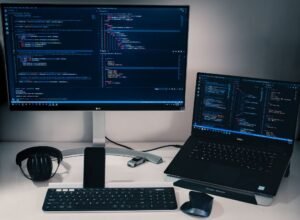Artificial Intelligence Images
Artificial Intelligence (AI) has revolutionized various fields, including image processing and analysis. With advancements in machine learning and deep learning algorithms, AI has become capable of understanding visual content in images like never before. In this article, we will explore the use of AI in image analysis and its implications in different industries.
Key Takeaways:
- Artificial Intelligence plays a crucial role in image analysis and processing.
- Machine learning and deep learning algorithms enable AI to understand visual content in images.
- The applications of AI in image analysis span across various industries.
Artificial Intelligence is now capable of accurately analyzing and interpreting images by leveraging machine learning algorithms. By training AI models on vast amounts of labeled data, they can identify objects, recognize patterns, and make predictions based on visual information. AI-powered image analysis has become a game-changer in areas such as medical imaging, autonomous vehicles, surveillance, and more.
*AI can learn from a vast collection of images to detect and classify objects with remarkable precision.*
Medical Imaging
In the field of medical imaging, AI enables faster and more accurate diagnosis by analyzing medical scans and images. AI algorithms can detect anomalies and patterns that may not be apparent to human eyes, aiding in the early detection of diseases such as cancer. Radiologists and healthcare professionals can benefit from AI’s ability to identify subtle nuances in medical images.
Autonomous Vehicles
*AI technology in autonomous vehicles enables real-time image recognition and object detection to navigate safely.*
AI is a crucial component of autonomous vehicles. Computer vision algorithms powered by AI help vehicles interpret information from cameras and sensors, enabling them to identify traffic signs, pedestrians, and other vehicles on the road. This technology plays a vital role in ensuring the safety and reliability of self-driving cars.
Surveillance and Security
AI has transformed surveillance systems by offering advanced image analysis capabilities. With AI-powered video analytics, security systems can detect unusual behavior, track individuals, and recognize faces, enhancing overall safety and security. By integrating AI into surveillance, it becomes easier to monitor large areas and identify potential threats or suspicious activities.
Data Tables
| Industry | Percentage of AI Adoption |
|---|---|
| Healthcare | 56% |
| Automotive | 43% |
| Security | 39% |
| Benefit | Description |
|---|---|
| Improved Accuracy | AI algorithms can analyze images with higher precision than traditional methods. |
| Time Efficiency | AI can process and analyze large quantities of images in a fraction of the time it would take humans. |
| Enhanced Diagnosis | AI aids in the early detection and diagnosis of diseases using medical imaging. |
Future Possibilities
The future of AI in image analysis is promising. As technology continues to advance, AI algorithms will become even more sophisticated in understanding and interpreting visual content. From improving medical diagnoses to enabling more advanced autonomous vehicles, the potential of AI in image analysis is limitless. Industries will continue to harness the power of AI to unlock new insights and drive innovation.
Data Privacy and Ethical Considerations
While AI offers significant benefits in image analysis, it is crucial to address concerns regarding data privacy and ethical implications. Proper protocols and regulations should be in place to ensure the responsible and ethical use of AI algorithms in analyzing images.
Conclusion
In conclusion, AI has revolutionized image analysis and processing. Its ability to understand visual content in images has paved the way for advancements in various industries, including healthcare, automotive, and security. As AI algorithms continue to improve, the future of image analysis holds immense potential for enhancing efficiency, accuracy, and innovation.

Common Misconceptions
AI Images and their Common Misconceptions
One common misconception people have about artificial intelligence (AI) images is that they can think and understand like humans. However, AI images are only designed to analyze and process visual data, but they lack general intelligence and do not have the ability to comprehend or think in the way humans do.
- AI images can recognize objects and patterns in images.
- AI images can perform tasks such as facial recognition and object detection.
- AI images cannot understand context or emotions associated with images.
Misconception about AI images replacing human creativity and artistry
Another common misconception is that AI images can replace human creativity and artistry. While AI-powered tools can assist in enhancing and generating visual content, they are not capable of creating original artwork that captures the depth and emotions of human experiences. AI images can imitate existing styles but lack the originality and creativity of human artists.
- AI images can generate realistic images based on existing data.
- AI images can mimic different artistic styles.
- AI images cannot replicate the unique human perspective in art.
Assumption that AI images are always accurate and unbiased
Some people assume that AI images always provide accurate and unbiased information. However, AI systems are trained using data sets that may contain biases, leading to potential inaccuracies and biases in the outputs. AI images are only as accurate and unbiased as the data they are trained on, and it is crucial to critically analyze and validate their results.
- AI images can sometimes misinterpret or misclassify images.
- AI images may reinforce existing biases in society.
- AI images require constant evaluation and human oversight to ensure accuracy.
Misconception surrounding the development of superintelligent AI images
There exists a misconception that AI images will eventually become superintelligent and surpass human capabilities. While AI technology continues to advance, achieving true superintelligence is an extremely complex and hypothetical scenario. Current AI images are designed with specific tasks in mind and do not possess the self-awareness or general intelligence necessary for superintelligent capabilities.
- AI images are limited to specific tasks and domains.
- Superintelligent AI images are speculative and not within current capabilities.
- AI images require human intervention for continuous improvement and adaptation.
Failure to distinguish between AI images and deepfakes
A common misconception is the failure to differentiate between AI-generated images and deepfakes. While both involve AI technology, AI images typically refer to computer-generated or enhanced images used for various purposes, such as image recognition. On the other hand, deepfakes specifically refer to manipulated videos or images that aim to deceive by superimposing faces or altering visual content.
- AI images focus on enhancing and generating visual content.
- Deepfakes involve intentionally deceiving or manipulating visuals.
- AI images are used for various purposes beyond deepfakes.

Artificial Intelligence Images Transforming Industries
Artificial Intelligence (AI) has made significant advancements in recent years, revolutionizing various industries. One area where AI has had a profound impact is in image recognition and processing. From improving medical diagnoses to enhancing self-driving cars, AI-powered image analysis is transforming the way we interact with technology. The following tables showcase some fascinating statistics and insights related to the use of AI in image-related applications.
AI in Medical Imaging
The application of AI in medical imaging has revolutionized the field of healthcare. By accurately analyzing medical images, AI algorithms aid in faster and more accurate diagnoses. The table below highlights some remarkable statistics regarding AI’s utilization in medical imaging.
| Statistic | Value |
|---|---|
| Percent increase in diagnostic accuracy using AI-assisted medical image analysis | 20-50% |
| Reduction in missed breast cancer cases with AI-powered mammography analysis | 30% |
| Decrease in false-positive rates in lung cancer detection with AI algorithms | over 40% |
AI in Autonomous Vehicles
The integration of AI in autonomous vehicles has opened up a realm of possibilities for safer and more efficient transportation. AI algorithms that interpret visual data are crucial for self-driving cars to navigate the roads. Explore the table below for intriguing facts related to AI’s impact on autonomous vehicles.
| Statistic | Value |
|---|---|
| Number of images captured per second by AI-enabled autonomous vehicles | multiple thousands |
| Reduction in accidents due to AI-assisted collision avoidance systems | up to 90% |
| Percentage increase in fuel efficiency with AI-controlled traffic optimization | 15-20% |
AI in Social Media Image Analysis
Social media platforms extensively employ AI to analyze and understand the vast amount of visual content shared by users. These platforms utilize AI algorithms to improve personalized content recommendations, detect harmful content, and more. Take a look at the table below for intriguing insights into the role of AI in social media image analysis.
| Statistic | Value |
|---|---|
| Number of images uploaded to Instagram per day | over 100 million |
| Accuracy of AI algorithms in identifying offensive or explicit content on social media | over 95% |
| Percentage increase in engagement for posts with AI-applied image recognition tags | up to 40% |
AI in Art and Creativity
Artificial Intelligence has also made significant strides in the realm of art and creativity. AI algorithms can generate original artwork, assist in creative processes, and even compose music. Delve into the table below to explore interesting facts and figures related to AI’s influence on artistic endeavors.
| Statistic | Value |
|---|---|
| Price of the artwork generated by an AI algorithm sold at an auction | $432,500 |
| Percentage of creative professionals who believe AI will have a positive impact on their field | 75% |
| Number of AI-generated songs released on music platforms | over 10,000 |
AI in Satellite Image Analysis
Satellite imagery plays a vital role in various applications, ranging from urban planning to disaster management. The integration of AI in satellite image analysis has greatly enhanced our ability to process massive amounts of data efficiently. The table below unveils remarkable information regarding AI’s impact on satellite image analysis.
| Statistic | Value |
|---|---|
| Percentage improvement in efficiency in analyzing satellite images with AI algorithms | over 85% |
| Reduction in time required to detect and react to forest fires using AI-assisted satellite monitoring | up to 75% |
| Accuracy of AI algorithms in identifying damaged infrastructure from satellite images | over 90% |
AI in Security and Surveillance
AI-powered surveillance systems have transformed the way we monitor and secure public spaces. By analyzing real-time visual data, AI algorithms help identify potential threats and enhance public safety. The table below highlights intriguing statistics related to AI’s role in security and surveillance.
| Statistic | Value |
|---|---|
| Percentage increase in accuracy of facial recognition systems with AI integration | over 99% |
| Reduction in false alarms in video-based security systems using AI-powered object recognition | up to 75% |
| Number of surveillance cameras worldwide equipped with AI-enhanced capabilities | over 770 million |
AI in Astrophotography
AI has also found applications in the field of astrophotography, aiding in the analysis and enhancement of celestial images. By using AI algorithms, astronomers can extract deeper insights from vast amounts of astronomical data. Explore the table below for intriguing facts about AI’s impact on astrophotography.
| Statistic | Value |
|---|---|
| Percentage increase in accuracy of identifying celestial objects with AI-driven image analysis | over 80% |
| Reduction in time required to process and analyze astronomical images with AI assistance | over 60% |
| Improvement in resolution and detail in images captured by AI-supported telescopes | up to 30% |
AI in Sports Analysis
AI algorithms have made significant strides in revolutionizing the analysis of sports events, assisting athletes, coaches, and fans with valuable insights. The table below presents captivating statistics pertaining to AI’s impact on sports analysis.
| Statistic | Value |
|---|---|
| Percentage increase in accuracy of tracking player movements with AI-based computer vision systems | over 95% |
| Reduction in time required to analyze complex game situations using AI-assisted video analytics | up to 80% |
| Percentage improvement in predictive performance of AI algorithms in sports betting | over 20% |
AI in Fashion Industry
The fashion industry has embraced AI to improve various aspects, from designing to customer experience. AI-powered solutions enable personalized recommendations, virtual fitting rooms, and more. Explore the table below to discover fascinating insights into AI’s influence on the fashion industry.
| Statistic | Value |
|---|---|
| Increase in customer satisfaction with AI-powered personalized product recommendations | over 30% |
| Reduction in returns due to virtual fitting rooms utilizing AI-assisted augmented reality | up to 40% |
| Percentage increase in operational efficiency for fashion brands implementing AI in supply chain management | 15-20% |
Artificial Intelligence has revolutionized image analysis across various industries, bringing immense benefits and transforming the way we perceive and interact with the world. From accurately diagnosing medical conditions to improving transportation safety, the integration of AI has paved the way for countless advancements. As technology continues to advance, we can anticipate further breakthroughs and opportunities for AI to continue shaping our future.
Frequently Asked Questions
Artificial Intelligence Images
What is Artificial Intelligence (AI) in the context of images?
Artificial Intelligence (AI) in the context of images refers to the use of machine learning algorithms and computer vision techniques to perform various tasks related to images, such as image recognition, object detection, image generation, and image classification.
How does AI help in image recognition?
AI algorithms analyze the features and patterns present in an image to recognize and identify objects, faces, or other elements. These algorithms are trained using large datasets to improve accuracy and can be applied in various applications like self-driving cars, facial recognition, and medical imaging.
What is computer vision in AI?
Computer vision is a field of AI that focuses on enabling computers to understand and interpret visual information from images or videos. It involves techniques such as image processing, pattern recognition, and deep learning to analyze and extract meaningful information from visual data.
Can AI generate realistic images?
Yes, AI can generate realistic images using techniques such as generative adversarial networks (GANs) and variational autoencoders (VAEs). These algorithms learn to generate images that resemble training data by capturing the distribution of features and patterns present in the dataset. However, the realism of generated images may vary depending on the complexity of the task and the quality of the training data.
What are some applications of AI in image processing?
AI is used in various image processing applications, including object detection and recognition, image segmentation, content-based image retrieval, image restoration, medical image analysis, video surveillance, and augmented reality. These applications benefit from the ability of AI algorithms to analyze and understand images at a rapid pace with high accuracy.
How can AI improve image classification accuracy?
AI can improve image classification accuracy by leveraging deep learning algorithms, specifically convolutional neural networks (CNNs). These networks are designed to automatically learn relevant features from images by analyzing multiple layers of data. Through training on large image datasets, CNNs can recognize complex patterns and achieve higher classification accuracy compared to traditional image processing techniques.
What are the challenges in AI-powered image analysis?
Some challenges in AI-powered image analysis include handling large amounts of data, ensuring privacy and ethical use of images, dealing with bias and fairness issues, managing computational resources for complex algorithms, and addressing interpretability and transparency concerns of AI-driven decisions.
What is the future of AI in image processing?
The future of AI in image processing is promising. Advancements in deep learning, computer vision, and AI hardware are expected to lead to more accurate and efficient algorithms for image analysis. This will enable the development of innovative applications in areas such as autonomous vehicles, healthcare, entertainment, and security.
How can AI assist in medical image analysis?
AI can assist in medical image analysis by automating tasks such as tumor detection, disease diagnosis, and prognosis prediction. Machine learning algorithms can be trained on large medical image datasets to learn patterns indicative of various conditions, enabling faster and more accurate diagnoses. This has the potential to improve patient outcomes and enhance the efficiency of healthcare systems.
Are there any ethical implications associated with AI in image analysis?
Yes, there are ethical implications associated with AI in image analysis. These include privacy concerns related to the use of personal images, potential biases in algorithms that could result in unfair decisions, and the need for transparency and explainability in AI systems to ensure accountability. It is crucial to develop and adhere to ethical frameworks and regulatory policies to responsibly deploy AI technologies in image analysis.




